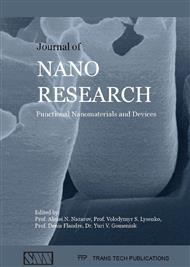[1]
S. Tiwari, F. Rana, H. Hanafi, A. Hartstein, E.F. Crabbe, K. Chan, A silicon nanocrystals based memory, Appl. Phys. Lett. 68 (1996) 1377-1379.
DOI: 10.1063/1.116085
Google Scholar
[2]
O.L. Bratus', A.A. Evtukh, V.A. Ievtukh, V.G. Litovchenko, Nanocomposite SiO2(Si) films as a medium for non-volatile memory. J. Non-Crystal. Solids, 354 (2008) 4278-4281.
DOI: 10.1016/j.jnoncrysol.2008.06.037
Google Scholar
[3]
A. Evtukh, O. Bratus', T. Gorbanyuk, V. Ievtukh, Electrical characterization of SiO2(Si) films as a medium for charge storage. Phys. Stat. Sol. (c). 5(12) (2008) 3663-3666.
DOI: 10.1002/pssc.200780165
Google Scholar
[4]
D.J. Lockwood, Light emission in silicon: from physics to devices, Semiconductors and Semimetals, Vol. 49, Academic press, San Diego, (1998).
Google Scholar
[5]
V. Kapaklis, C. Politis, P. Poulopoulos, P. Schweiss, Photoluminescence from silicon nanoparticles prepared from bulk amorphous silicon monoxide by the disproportionation reaction, Appl. Phys. Lett. 87, 123114 (2005).
DOI: 10.1063/1.2043246
Google Scholar
[6]
H. Rinnert, O. Jombois, M. Vergnat, M. Molinari, Study of the photoluminescence of amorphous and crystalline silicon clusters in SiOx thin films, Optical Materials, 27, 983-987 (2005).
DOI: 10.1016/j.optmat.2004.08.048
Google Scholar
[7]
H.I. Hanafi, S. Tiwari, I. Khan, Fast and long retention-time nano-crystal memory, IEEE Trans. Electron Dev. ED-43, 1553 (1996).
DOI: 10.1109/16.535349
Google Scholar
[8]
P. Normand, D. Tsoukalas, E. Kapetanakis, J.A. Van Der Berg, D.G. Armour, J. Stoemenos, C. Vieu, Electrochem. Solid-State Lett. 1, 88 (1998).
Google Scholar
[9]
J. von Borany, K.H. Heinig, R. Grotzschel, M. Klimenkov, M. Strobel, K.H. Stegemann, H.K. Thees, Microelectron. Eng. 48, 231 (1999).
DOI: 10.1016/s0167-9317(99)00377-9
Google Scholar
[10]
Li-Ping You, C.L. Heng, S.Y. Ma, Z.C. Ma, W.H. Zong, G.G. Long Wu, J. Cryst Growth 212, 109 (2000).
Google Scholar
[11]
L. Caristia, G. Nicotra, C. Bongiorno, N. Costa, S. Ravesi, S. Coffa, R. De Bastiani, M.G. Grimaldi, C. Spinella, The influence of hydrogen and nitrogen on the formation of Si nanoclusters embedded in sub-stoichiometric silicon oxide layers, Microelectron. Reliability. 47, 777-780 (2007).
DOI: 10.1016/j.microrel.2007.01.056
Google Scholar
[12]
F. Iacona, G. Franzo, C. Spinella, Correlation between luminescence and structural properties of Si nanocrystals , J. Appl. Phys. 87, 1295 (2000).
DOI: 10.1063/1.372013
Google Scholar
[13]
F. Iacona, C. Bongiorno, C. Spinella, S. Boninelli, F. Priolo, Formation and evolution of luminescent Si nanoclusters produced by thermal annealing of SiOx films, J. Appl. Phys. 95, 3723 (2004).
DOI: 10.1063/1.1664026
Google Scholar
[14]
M. Ben-Chorin, and F. Koch, Nonlinear electrical transport in porous silicon, Phys. Rev. B 49, 2981, (1994).
DOI: 10.1103/physrevb.49.2981
Google Scholar
[15]
H.W. Lau, O.K. an, and D.A. Trigg, Charge injection and tunneling mechanism of solid state reaction silicon nanocrystal film, Appl. Phys. Lett. 89, 113119 (2006).
DOI: 10.1063/1.2345257
Google Scholar
[16]
D. Song, E. C. Cho, G. Conibeer, Y. Huang, and M.A. Green, Fabrication and electrical characteristics of Si nanocrystal/c-Si heterojunctions, Appl. Phys. Lett. 91, 123510 (2007).
DOI: 10.1063/1.2787883
Google Scholar
[17]
B. Berghoff, S. Suckow, R. Rölver, B. Spangenberg, H. Kurz, A. Sologubenko and J. Mayer, Improved charge transport through Si based multiple quantum wells with substoichiometric SiOx barrier layers. J. Appl. Phys. 106, 083706 (2009).
DOI: 10.1063/1.3238294
Google Scholar
[18]
M.A. Lampert and P. Mark, Current Injection in Solids (Academic, New York, 1970).
Google Scholar
[19]
N.F. Mott and E.A. Davis, Electronic Processes in Non-cristalline Materials, second ed., Oxford University Press, Oxford, (1979).
Google Scholar
[20]
C. Godet, Variable range hopping revisited: the case of an exponential distribution of localized states. J. Non-Cryst. Solids. 333, 299–302 (2002).
DOI: 10.1016/s0022-3093(01)01008-0
Google Scholar
[21]
K.C. Kao and W. Hwang, Electrical Transport in Solids (Pergamon, Oxford, 1981).
Google Scholar
[22]
Y. Caglar, M. Caglar, S. Ilican, and F. Yakuphanoglu, Thermally stimulated current and space charge limited current mechanism in film of the gold/zinc oxide/gold type, Physica B 392, 99 (2007).
DOI: 10.1016/j.physb.2006.11.014
Google Scholar
[23]
P. Mark and W. Helfrich, Space-Charge-Limited Currents in Organic Crystals, J. Appl. Phys. 33, 205 (1962).
DOI: 10.1063/1.1728487
Google Scholar
[24]
V. Kumar, S.C. Jain, A.K. Kapoor, W. Geens, T. Aernauts, J. Poortmans, and R. Mertens, Trap density in conducting organic semiconductors determined from temperature dependence of J−V characteristics, J. Appl. Phys. 94, 1283 (2003).
DOI: 10.1063/1.1582552
Google Scholar
[25]
S.M. Sze, Physics of semiconductor Devices (Wiley-Interscience, Hoboken, 2007).
Google Scholar


